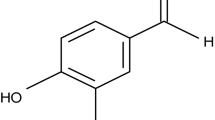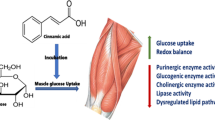Abstract
The insulin-like effects of peroxovanate (POV) and peroxovanadyl (PSV) on rates of lactate formation and glycogen synthesis were measured in isolated incubated soleus muscle preparations. In another experiment rats were made insulin deficient by streptozotocin injection and treated with POV and PSV (0.25 mM) administered in the drinking water and in the course of 7 days glycemia were determined. Also, signal transduction proteins ERK 1 and ERK 2 involved in the insulin signaling were measured in soleus muscle of diabetic rats treated with POV and PSV. Peroxides of vanadate and vanadyl significantly stimulated glucose utilization in soleus muscle preparations in vitro. The stimulation of glycogen synthesis and lactate formation by POV and PSV was similar to insulin stimuli. Rats treated with POV or PSV presented reduction of glycemia, food and fluid intake with amelioration of the diabetic state during the short period of treatment (7 days). POV and PSV modulated ERK1/2 phosphorilation and the insulin administration in these rats caused an addictive effect on phosphorilation state of these proteins.
Similar content being viewed by others
References
Brichard SM, Henquim J: The role of vanadium in the management of diabetes. TiPS 16: 265–270, 1995
O’Connell BS: Select vitamins and minerals in the management of diabetes. Diab Spect 14: 133–148, 2001
Nielsen FH: Nutritional requirements for boron, silicon, vanadium, nickel, and arsenic: Current knowledge and speculation. FASEB J 5: 2661–2667, 1991
Lyonnet BM, Martz Martin E: La Presse Medicale 7: 191–192, 1899
Heyliger CE, Tahiliani AG, McNeill JH: Effect of vanadate on elevated blood glucose and depressed cardiac performance of diabetic rats. Science 22(4693): 1474–1477, 1985
Cam MC, Brownsey RW, McNeill JH: Mechanisms of vanadium action: Insulin-mimetic or insulin-enhancing agent? Can J Physiol Pharmacol 78: 829–847, 2000
Carey JO, Azevedo JL, Morris PG, Pories WJ, Dohm GL: Okadaic acid, vanadate, and phenylarsine oxide stimulate 2-deoxyglucose transport in insulin-resistant human skeletal muscle. Diabetes 44: 682–688, 1995
Dubyak GR, Kleinzeller A: The insulin-mimetic effects of vanadate in isolated rat adipocytes. Dissociation from effects of vanadate as a Na/K-ATPase inhibitor. J Biol Chem 255: 5306–5312, 1980
Clark AS, Fagan JM, Mitch WE: Selectivity of the insulin-like actions of vanadate on glucose and protein metabolism in skeletal muscle. Biochem J 232: 273–276, 1985
Shechter Y, Karlish SJ: Insulin-like stimulation of glucose oxidation in rat adipocytes by vanadyl (IV) ions. Nature 284: 556–558, 1980
Duckworth WC, Solomon SS, Liepnieks J, Hamel FG, Hand S, Peavy DE: Insulin-like effects of vanadate in isolated rat adipocytes. Endocrinology 122: 2285–2289, 1988
Degani I, Gochin M, Karlish SJD, Shechter Y: Biochemistry 20: 5795, 1981
Bosch F, Iatzoglov M, Park EA, Hanson RW: J Biol Chem 265: 13677–13682, 1990
Verma S, Cam MC, McNeill J: H. Nutritional factors that can favorably influence the glucose/insulin system: Vanadium. J Am Coll of Nutr 17: 11–18, 1998
Bailey CJ: Potential new treatments for type 2 diabetes. Tips 21: 259–265, 2000
Moller DE: New drug targets for type 2 diabetes and the metabolic syndrome. Nature 414: 821–827, 2001
Balasubramanyam M, Mohan V: Orally active insulin mimics: Where do we stand now? J Biosci 383–390, 2001
Marzban L, McNeill JH: Biological effects of vanadium: Possible mechanisms of action. BITREL 108–112, 2002
Brichard SM, Okitolonda W, Henquin JC: Long-term improvement of glucose homeostasis by vanadate treatment in diabetic rats. Endocrinology 123: 2048–2053, 1980
Srivastava AK: Anti-diabetic and toxic effects of vanadium compounds. Mol Cell Biochem 206: 177–182, 2000
Domingo JL, Gomez M, Llobet JM, Corbella J, Keen CL: Oral vanadium administration to streptozotocin-diabetic rats has marked negative side-effects which are independent of the form of vanadium used. Toxicology 66: 279–287, 1991
Shisheva A, Ikonomov O, Shechter Y: The protein tyrosine phosphatase inhibitor, pervanadate, is a powerful antidiabetic agent in streptozotocin-treated diabetic rats. Endocrinology 134: 507–510, 1994
Brand RM, Hamel FG: Transdermally delivered peroxovanadium can lower blood glucose levels in diabetic rats. Int J Pharm 183: 117–123, 1999
Kadota S, Fantus IG, Deragon G, Harvey JG, Hersh B, Posner BI: Peroxide(s) of vanadium: A novel and potent insulin-mimetic agent which activates the insulin receptor kinase. Biochem Bioph Res Co 147: 259–266, 1987
Leighton B, Dimitriadis GD, Parry-Billings M, Lozeman FJ, Newsholme EA: Effects of aging on the responsiveness and sensitivity to insulin in the incubated soleus muscle isolated from Sprague-Dawley and Wistar rats. Biochem J 261: 383–387, 1989
Trinder R: Determination of glucose in blood using glucose with alternative oxygen acceptor. Ann Clin Biochem 6: 27–27, 1969
Carvalho CRO, Brenelli SL, Silva AC, Nunes ALB, Saad MJA: Effect of aging on insulin receptor, insulin receptor substrate-1, and phosphatidylinositol 3-kinase in liver and muscle of rats. Endocrinology 137: 151–159, 1996
Saad MJ, Araki E, Miralpeix M, Rothenberg PL, White MF, Kahn CR: Regulation of insulin receptor substrate-1 in liver and muscle of animal models of insulin resistance. J Clin Invest 90: 1839–1849, 1992
Bradford MM: A rapid and sensitive method for the quantitation of microgram quantities utilizing the principle of protein dye binding. Anal Biochem 142: 79–83, 1976
Laemmli UK: Cleavage of structural proteins during the assembly of the head of bacteriophage. Nature 227: 680–685, 1970
Towbin H, Staehelin T, Gordon J: Electrophoretic transfer of proteins from plyacrylamide gels to nitrocellulose sheets: Procedure and some applications. Proc Natl Acad Sci USA 76: 4350–4354, 1979
Foot E, Bliss T, Fernandes LC, Da Costa C, Leighton B: The effects of orthovandate, vanadyl and peroxides of vanadate on glucose metabolism in skeletal muscle preparations in vitro. Mol Cell Biochem 109: 157–162, 1992
Cam MC, Rodrigues B, McNeill JH: Distinct glucose lowring and beta cell protective effects of vanadium and food restriction in streptozotocin-diabetes. Eur J Endocrinol 141: 546–554, 1999
Malabu UH, Dryden S, McCarthy HD, Kilpatrick A, Williams G: Effects of chronic vanadate administration in the STZ-induced diabetic rat. The antihyperglycemic action of vanadate is attributable entirely to its suppression of feeding. Diabetes 43: 9–15, 1994
Thompson KH, Leichter J, McNeill JH: Studies of vanadyl sulphate as a glucose-lowering agent in STZ-diabetic rats. Biochem Biophys Res Co 197: 1549–1555, 1993
Yuen VG, Orvig C, McNeill JH: Effects of bis9maltolato)oxovanadium (IV) are distinct from food restriction in STZ-diabetic rats. Am J Physiol 272: 30–35, 1997
Wang J, Yuen VG, McNeill JH: Effect of vanadium on insulin sensitivity and appetite. Metabolism 50: 667–673, 2001
Evangelou AM: Vanadium in cancer treatment. Crit Rev Oncol Hemat 42: 249–265, 2002
Sreekumar R, Halvatsiotis P, Schimke JC, Nair KS: Gene expression profile in skeletal muscle of type 2 diabetes and the effect of insulin treatment. Diabetes 51: 1913–1920, 2002
Lecker SH, Jagoe RT, Gilbert A, Gomes M, Baracos V, Bailey CJ, Price SR, Mitch WE, Goldberg AL: Multiple types of skeletal muscle atrophy involve a common program of changes in gene expression. FASEB J 18: 39–51, 2004
Author information
Authors and Affiliations
Corresponding author
Rights and permissions
About this article
Cite this article
Yamazaki, R.K., Hirabara, S.M., Tchaikovski, O. et al. The effects of peroxovanadate and peroxovanadyl on glucose metabolism in vivo and identification of signal transduction proteins involved in the mechanism of action in isolated soleus muscle. Mol Cell Biochem 273, 145–150 (2005). https://doi.org/10.1007/s11010-005-8265-5
Received:
Accepted:
Issue Date:
DOI: https://doi.org/10.1007/s11010-005-8265-5




